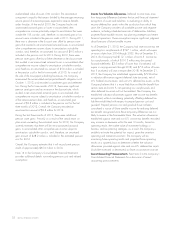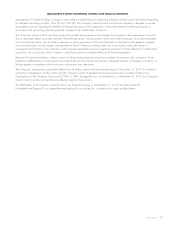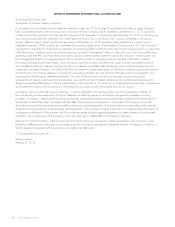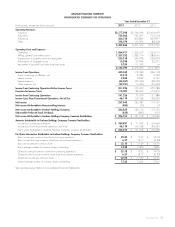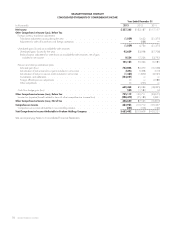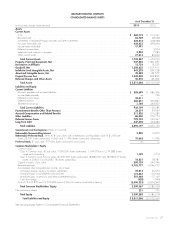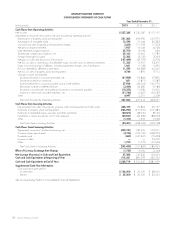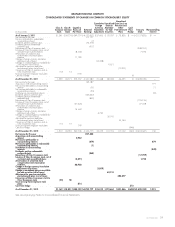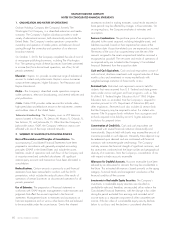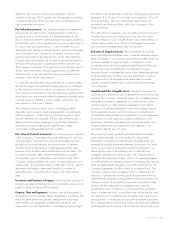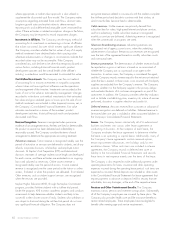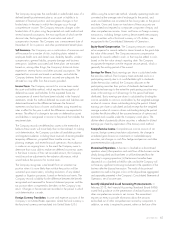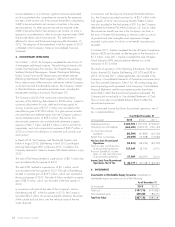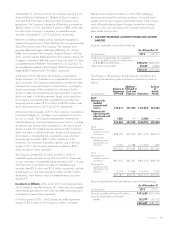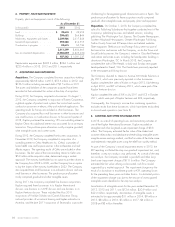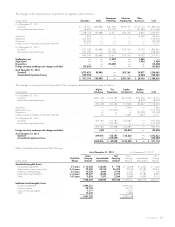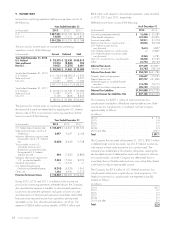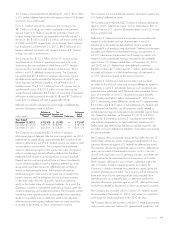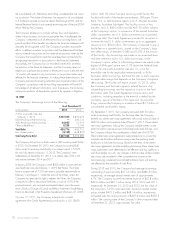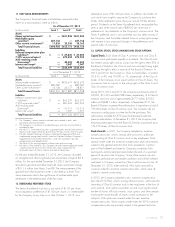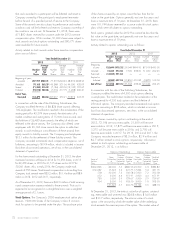Washington Post 2013 Annual Report Download - page 80
Download and view the complete annual report
Please find page 80 of the 2013 Washington Post annual report below. You can navigate through the pages in the report by either clicking on the pages listed below, or by using the keyword search tool below to find specific information within the annual report.where appropriate, a market value approach is also utilized to
supplement the discounted cash flow model. The Company makes
assumptions regarding estimated future cash flows, discount rates,
long-term growth rates and market values to determine each
reporting unit’s and indefinite-lived intangible asset’s estimated fair
value. If these estimates or related assumptions change in the future,
the Company may be required to record impairment charges.
Investments in Affiliates. The Company uses the equity method of
accounting for its investments in and earnings or losses of affiliates
that it does not control, but over which it exerts significant influence.
The Company considers whether the fair values of any of its equity
method investments have declined below their carrying value
whenever adverse events or changes in circumstances indicate that
recorded values may not be recoverable. If the Company
considered any such decline to be other than temporary (based on
various factors, including historical financial results, product
development activities and the overall health of the affiliate’s
industry), a write-down would be recorded to estimated fair value.
Cost Method Investments. The Company uses the cost method
of accounting for its minority investments in nonpublic companies
where it does not have significant influence over the operations
and management of the investee. Investments are recorded at the
lower of cost or fair value as estimated by management. Charges
recorded to write down cost method investments to their estimated
fair value and gross realized gains or losses upon the sale of cost
method investments are included in other (expense) income, net, in
the Company’s Consolidated Financial Statements. Fair value
estimates are based on a review of the investees’ product
development activities, historical financial results and projected
discounted cash flows.
Revenue Recognition. Revenue is recognized when persuasive
evidence of an arrangement exists, the fees are fixed or determinable,
the product or service has been delivered and collectability is
reasonably assured. The Company considers the terms of each
arrangement to determine the appropriate accounting treatment.
Education revenues. Tuition revenue is recognized ratably over the
period of instruction as services are delivered to students, net of any
refunds, corporate discounts, scholarships and employee tuition
discounts. At Kaplan’s Test Preparation (KTP) and International
divisions, estimates of average student course length are developed
for each course, and these estimates are evaluated on an ongoing
basis and adjusted as necessary. Online access revenue is
recognized ratably over the period of access. Course material
revenue is recognized over the same period as the tuition or online
access, if related, or when the products are delivered, if not related.
Other revenues, such as student support services, are recognized
when the services are provided.
Kaplan Higher Education (KHE), through the Kaplan Commitment
program, provides first-time students with a risk-free trial period.
Under the program, KHE monitors academic progress and conducts
assessments to help determine whether students are likely to be
successful in their chosen course of study. Students who withdraw or
are subject to dismissal during the risk-free trial period do not incur
any significant financial obligation. The Company does not
recognize revenues related to coursework until the students complete
the risk-free period and decide to continue with their studies, at
which time the fees become fixed or determinable.
Cable revenues. Cable revenues are primarily derived from
subscriber fees for video, high-speed Internet and phone services,
and from advertising. Cable subscriber revenue is recognized
monthly as services are delivered. Advertising revenue is recognized
when the commercials or programs are aired.
Television broadcasting revenues. Advertising revenues are
recognized, net of agency commissions, when the underlying
advertisement is broadcast. Retransmission revenues are recognized
over the term of the agreement based on monthly subscriber counts
and contractual rates.
Revenue presentation. The determination of whether revenue should
be reported on a gross or net basis is based on an assessment of
whether the Company acts as a principal or an agent in the
transaction. In certain cases, the Company is considered the agent,
and the Company records revenue equal to the net amount retained
when the fee is earned. In these cases, costs incurred with third-party
suppliers are excluded from the Company’s revenue. The Company
assesses whether it or the third-party supplier is the primary obligor
and evaluates the terms of its customer arrangements as part of this
assessment. In addition, the Company considers other key indicators
such as latitude in establishing price, inventory risk, nature of services
performed, discretion in supplier selection and credit risk.
Deferred revenue. Amounts received from customers in advance of
revenue recognition are deferred as liabilities. Deferred revenue to
be earned after one year is included in other noncurrent liabilities in
the Company’s Consolidated Financial Statements.
Leases. The Company leases substantially all of its educational
facilities and enters into various other lease agreements in
conducting its business. At the inception of each lease, the
Company evaluates the lease agreement to determine whether
the lease is an operating or capital lease. Additionally, many of
the Company’s lease agreements contain renewal options,
tenant improvement allowances, rent holidays and/or rent
escalation clauses. When such items are included in a lease
agreement, the Company records a deferred rent asset or
liability in the Consolidated Financial Statements and records
these items in rent expense evenly over the terms of the lease.
The Company is also required to make additional payments under
operating lease terms for taxes, insurance and other operating
expenses incurred during the operating lease period; such items are
expensed as incurred. Rental deposits are included as other assets
in the Consolidated Financial Statements for lease agreements that
require payments in advance or deposits held for security that are
refundable, less any damages, at the end of the respective lease.
Pensions and Other Postretirement Benefits. The Company
maintains various pension and incentive savings plans. Substantially
all of the Company’s employees are covered by these plans. The
Company also provides health care and life insurance benefits to
certain retired employees. These employees become eligible for
benefits after meeting age and service requirements.
62 GRAHAM HOLDINGS COMPANY


